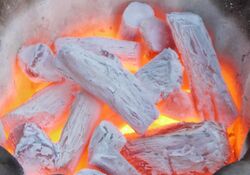Chemistry:Binchōtan
Binchō-tan (Japanese: 備長炭), also called white charcoal or binchō-zumi, is a type of charcoal traditionally used in Japanese cooking. Its use dates to the Edo period, when, during the Genroku era, a craftsman named Bichū-ya Chōzaemon (備中屋 長左衛門) began to produce it in Tanabe, Wakayama. The typical raw material used to make binchō-tan in Japan is oak, specifically Quercus phillyraeoides (ja), now the official tree of Wakayama Prefecture. Wakayama continues to be a major producer of high-quality charcoal, with the town of Minabe, Wakayama, producing more binchō-tan than any other town in Japan. Binchō-tan produced in Wakayama is referred to as Kishū binchō-tan (紀州備長炭), Kishū being the old name of Wakayama.
White charcoal is made by pyrolysing wood in a kiln at approximately 240 °C (464 °F) for 120 hours, then raising the temperature to around 1,000 °C (1,830 °F). Once carbonised, the material is taken out and covered in a damp mixture of earth, sand and ash.[1]
Binchō-tan is a type of hardwood charcoal which takes the natural shape of the wood that was used to make it. It is also harder than black charcoal, ringing with a metallic sound when struck. Due to its physical structure, binchō-tan takes on a whiter or even metallic appearance and, apart from being used for cooking, has other benefits such as absorption of odors[citation needed].
In comparison, oga-tan is a type of biomass briquettes - a sawdust charcoal compressed into shapes with angular edges, often with a hole in the center. There exists a common misconception amongst restaurants and chefs that causes them to refer to oga-tan as binchō-tan[citation needed].
Wind chimes and a musical instrument, the tankin ("charcoal-xylophone"), have been made from Binchō-tan.
References
- ↑ Chia, C. H.; Munroe, P.; Joseph, S. D. (2012). "Microstructural Characterization of White Charcoal". Journal of Analytical & Applied Pyrolysis 18 (S2): 1562. doi:10.1017/S143192761200966X. Bibcode: 2012MiMic..18S1562C. https://pure.mpg.de/rest/items/item_2039396/component/file_2039397/content. Retrieved 29 April 2020.
External links
- 紀州備長炭 —Making of Kishū Binchōtan by Wakayama Pref.
- 炭琴 —Tankin ("charcoal-xylophone")
- "Charcoal Adds to the Good Life" – an article from 2001 touting the benefits of black and white charcoal, the latter including binchōtan
 |




